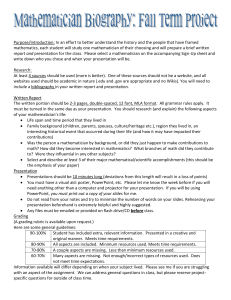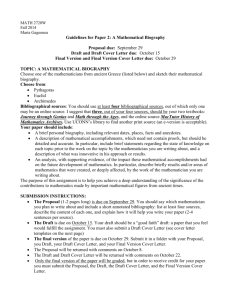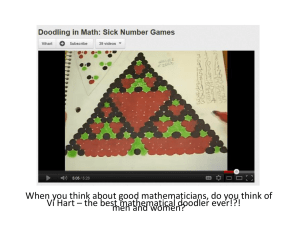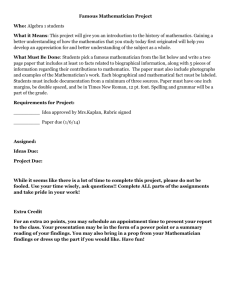Thinking Analysis to the Process of Mathematical Creativity of
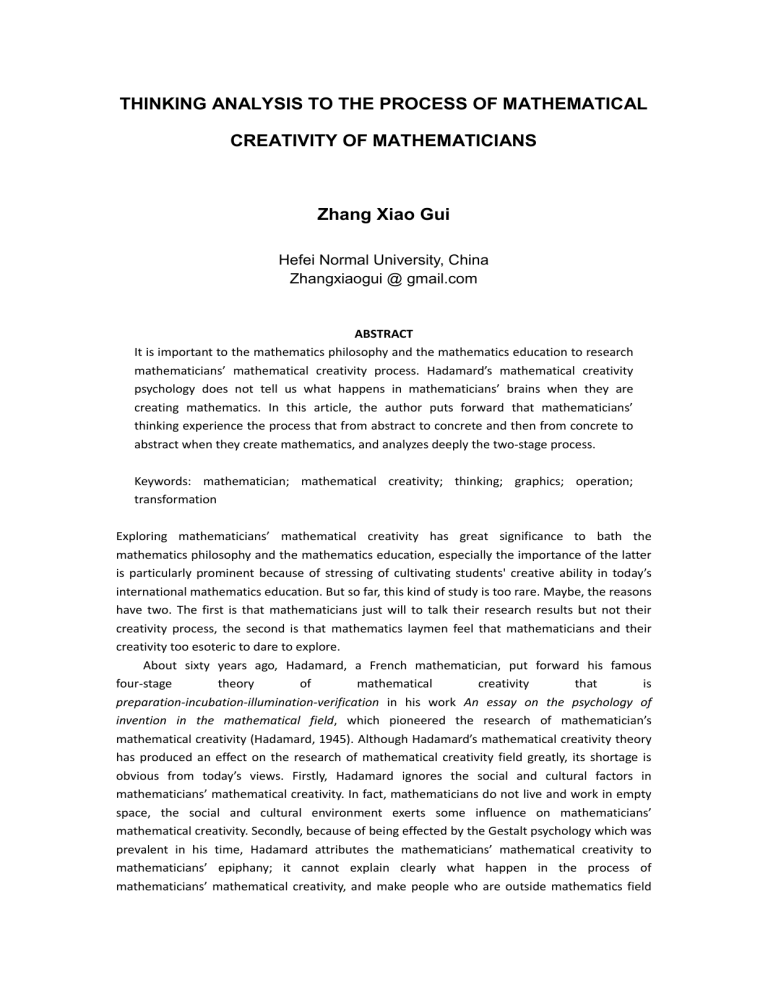
THINKING ANALYSIS TO THE PROCESS OF MATHEMATICAL
CREATIVITY OF MATHEMATICIANS
Zhang Xiao Gui
Hefei Normal University, China
Zhangxiaogui @ gmail.com
ABSTRACT
It is important to the mathematics philosophy and the mathematics education to research mathematicians’ mathematical creativity process. Hadamard’s mathematical creativity psychology does not tell us what happens in mathematicians’ brains when they are creating mathematics. In this article, the author puts forward that mathematicians’ thinking experience the process that from abstract to concrete and then from concrete to abstract when they create mathematics, and analyzes deeply the two-stage process.
Keywords: mathematician; mathematical creativity; thinking; graphics; operation; transformation
Exploring mathematicians’ mathematical creativity has great significance to bath the mathematics philosophy and the mathematics education, especially the importance of the latter is particularly prominent because of stressing of cultivating students' creative ability in today’s international mathematics education. But so far, this kind of study is too rare. Maybe, the reasons have two. The first is that mathematicians just will to talk their research results but not their creativity process, the second is that mathematics laymen feel that mathematicians and their creativity too esoteric to dare to explore.
About sixty years ago, Hadamard, a French mathematician, put forward his famous four-stage theory of mathematical creativity that is
preparation-incubation-illumination-verification in his work An essay on the psychology of
invention in the mathematical field, which pioneered the research of mathematician’s mathematical creativity (Hadamard, 1945). Although Hadamard’s mathematical creativity theory has produced an effect on the research of mathematical creativity field greatly, its shortage is obvious from today’s views. Firstly, Hadamard ignores the social and cultural factors in mathematicians’ mathematical creativity. In fact, mathematicians do not live and work in empty space, the social and cultural environment exerts some influence on mathematicians’ mathematical creativity. Secondly, because of being effected by the Gestalt psychology which was prevalent in his time, Hadamard attributes the mathematicians’ mathematical creativity to mathematicians’ epiphany; it cannot explain clearly what happen in the process of mathematicians’ mathematical creativity, and make people who are outside mathematics field
feel mathematics mysterious and mathematical creativity incomprehensible. After Hadamard, some researchers also tried to explore mathematicians’ mathematical creativity, but unfortunately, they have not been able to surpass Hadamard’s theory really (zhang, 2010). In the paper Thinking about the Mathematics Creativity from Social Views, the author explores mathematicians’ mathematical creativity from the social perspectives, puts forward six-stage mathematical creativity theory which is
problem-preparation-incubation-illumination-verification-approving (ibid). Author’s work made up the shortage of the Hadamard’s mathematical creativity partly, but it still does not show clearly what happens in the mathematicians’ brains when they are thinking mathematics. In this article, the author hopes to explain mathematicians’ thinking activities in the process of their mathematical creativity. It is well known that human’s epistemological activities have two basic ways which are from abstract to concrete and from concrete to abstract. Accord to the following analysis, we can find that mathematicians’ thinking activities experience the process of being from abstract to concrete and then from concrete to abstract. This process shows that mathematicians’ mathematical creativity is not mysterious, and it is accord with human’s epistemological ways. Obviously, mathematicians’ mathematical creativity begins from posing conjecture. Posing mathematical conjecture is very complex and involves with a lot of mathematical thinking activities, but we begin our analysis from mathematician’s facing a mathematics conjecture in this paper.
From abstract to concrete
Mathematics is created by the mathematicians, and mathematicians’ mathematical creativity is the result of their thinking which happens in their brains, simply speaking, mathematics is the result of mathematicians’ thinking. There is a question which ought to be answered. This question is that what is the manifestation of the mathematics object in his/her brain when the mathematician is creating mathematics or thinking mathematics? It seems an individualized question, but there is quite same answer, which is that the object of mathematical thinking presents itself as the form of graphics in the mathematician’s brain. To most mathematicians, it is true. Many mathematicians’ descriptions of their mathematical creativity and some researchers’ investigations to mathematicians’ mathematical creativity can obtain such conclusion. When talking about mathematical creativity himself, Hadamard said: ”I insist that words are totally absent from my mind when I really think...even after reading or hearing a question, every word disappears the very moment that I am beginning to think it over”(Devlin,
2008). Einstein also wrote: “Words and language, whether written or spoken, do not seem to play any part in my thought processes. The psychological entities that serve as building blocks for my thought are certain signs or images, more or less clear, that I can reproduce and recombine at will”(ibid). Hadamard and Einstein represent past mathematicians, then, how do mathematicians today think when they create mathematics? In a recent survey, Burton found that more than half of the mathematicians surveyed (66%) believe their thinking objects are graphics when they create mathematics (Burton, 2001). So, for most mathematicians, their thinking objects are graphics when they create mathematics. That is to say, mathematicians’ thinking is thinking to graphics. In Hadamard’s mathematical creativity four-stage model, when mathematicians enter the incubation stage, they begin to think to graphics. A further issue is that where do the graphics
in the mathematician’ brain come from?
A mathematical conjecture is an abstract proposition which is constituted by the mathematical language, but the graphics in the mathematician’ brain is concrete. The abstract proposition and concrete graphics are completely different in form. Obviously, mathematicians must transform the abstract proposition to the concrete graphics. How do mathematicians make the transformation? This process is so complex and individualized that the author cannot analyze in deeper lever what happens in the mathematician’s brain. To be sure, this complex process involves mainly the non-logic thinking which plays a key role; and the logic thinking plays a minor role which even can be ignored in this process. Peirce, an American mathematician and philosopher, called the graphics as diagram. He pointed that there are two kinds of diagrams which are geometric diagram and algebraic diagram. The geometric diagram is constituted by geometric lines and the algebraic diagram by letters and other algebraic symbols. To the diagram,
Peirce said popularly: “with ordinary persons this is always a visual image, or mixed visual and muscular” (Hull, 1994).
There is another question which must be answered. Why do mathematicians want to transform the abstract proposition to the concrete graphics rather than other forms? The theory of functional asymmetry in the human brain thinks that the functions of left and right hemisphere are different. The left hemisphere is usually connected with logical thinking, whereas the right hemisphere mainly with non-logical thinking. Several investigations show that the two cerebral hemispheres process stimuli in different ways. The left hemisphere processes stimuli sequentially, whereas the right hemisphere is specialized in parallel processing (Pehkonen, 1997).
Obviously, the left hemisphere is better suited for arithmetic, solving procedural mathematics exercises, and analytic deduction in mathematics education, whereas the right hemisphere is better in intuitions, imagination, and solving non-procedural mathematics problems.
From the above theory, the mathematical creativity mainly happens in the mathematician’s right hemisphere, which is better suited for non-logical thinking. In the right hemisphere, the mathematician can make creative thinking such as imagination and intuition when he/she transforms an abstract proposition to the concrete graphics. We can say that transforming an abstract proposition to the concrete graphics is the mathematician’s inevitable choice.
Колмогоров (Kolmogorov), a famous mathematician of the former Soviet Union, said:” if it is possible, mathematician always tries to make their problem geometric visualization … …geometric imagination, or as ordinary people talking about the geometric intuition, is great significance to almost all mathematical research branch even the most abstract work (Shao, 1996)”. It seems that Колмогоров thinks that transforming an abstract proposition to the concrete graphics is mathematician’s preference. According to above analysis, transforming an abstract proposition to the concrete graphics is the function of mathematician’s brain rather than their preference.
After having finished the transformation, the mathematician faces the concrete graphics rather than the abstract proposition. Because of facing the concrete graphics, the mathematician begins to manipulate the graphics. It is very clear that the mathematician’s spatial imagination plays a key role in this stage. Problem-solving means to set relation between the known conditions and the results which are needed, so, the aim of manipulating graphics is to convert the initial graphics which meets the conditions to the finial graphics which is consistent with the result. As soon as the relation’s linked, the graphics’ manipulating finished. At moment, the problem is
solved in a great extent.
Mathematician Devlin did a very vivid description to operating graphics (Devlin, 2008). He compared mathematics problem solving to decorating a new house. When a person goes in a new house where the disorganized furniture is cumulated, he is not familiar with the house’s layout. He wants to put every piece of furniture to the appropriate location in the house. In order to put the every piece of furniture to the most appropriate location, he needs to be well acquainted with the house’s layout, every piece of furniture’s function and its size. After trying many times, he ultimately arranges all furniture in their most appropriate location. Obviously, more furniture and the house’s layout more complex, more difficult he/she arranges. In this metaphor, the knowledge-masses which are used to solve problem are compared to furniture.
Initially, these knowledge-masses are chaotic. The mathematician tries to operate these knowledge-masses, make them linking the problem’s results. After trying many times, the problem is solved eventually.
Peirce explained clearly the transformation from an abstract mathematical conjecture to the diagram and how the mathematician operates the diagram. Peirce not only showed what is thinking object in mathematician’s brain, but also explained how the mathematician thinks.
Peirce proposed that mathematician transforms a conjecture which is purely mathematical to the diagram in his/her brain by imagination. Then, he/she observes, analyzes and experiments to the diagram in his/her brain still by imagination; the experimental operation to the diagram includes adding some ingredients such as lines and changing the shape. Mathematician’s experimental operation in the brain is similar with natural scientist’s laboratory experimental operation. The differences are that the former happens in the mathematician’s brain and the latter in the scientist’s laboratory, the former’s experimental object is diagram and the latter’s physical object.
Peirce thought that both are same in essence. Peirce fully affirmed the importance of experimental access to the truth; he never considered human beings have the ability to get the truth with no help from the experiment and only by virtue of inner contemplation. Peirce believed that all human knowledge begins from the experiment, and the experiment includes the experiments conducted by the individual in mind. The experimental process will be accompanied by a series of surprise, which is directly perceived rather than reasoning. Mathematician’s experiment to the diagram in the brain leads to new observations, which, as Peirce said, makes our finding “the unnoticed and hidden relations between the various parts "(Hull, 1994).
Mathematician takes a variety of ways to carry out experiments on the diagram, until he sees the results of an experiment solving the problem or confirming the hypothesis.
Operating the graphics is not smooth. In the mathematics history, it was not uncommon to find a mathematician who spent many years even his whole life but failed to solve a mathematics problem. To most mathematicians, they will put the problems which cannot be solved for a while aside, and begin to solve a new problem. So, they always face a few of problems at the same time.
In other words, mathematician has a few of problems in his/her brain to be solved at any time. In these problems, there is a problem which be solved by the mathematician consciously, and the others are put aside. We can call the former the explicit problem and the latter the implicit problems. The explicit problem and the implicit ones are alternate. The mathematician always has an explicit problem in any time.
In the mathematics history, it is easy to find that a mathematician solved a problem suddenly when he /she was doing something which maybe is no correlation with the mathematics problem.
For example, Hamilton discovered the quaternions suddenly when he was walking alone the
Royal Canal in Dublin on 16 October in 1843, and Poincare got the ideas of solving the Fuchsian functions’ transformation methods when he was stepping in the car. The mathematician’ sudden problem solving is called epiphany by Hadamard. Hadamard made two Hypotheses to explain mathematicians’ epiphany. One is rest-hypothesis and the other is forgotten- hypothesis
(Hadamard, 1945). In the rest-hypothesis, the mathematician’s brain is in a new state when a mathematics problem which cannot be solved temporarily is put aside by him/her, the new brain state of the mathematician is conducive to the epiphany; and in the forgotten-hypothesis, if a mathematician’s brain gets rid of the wrong load, it will solve the problem in an open thinking.
Krutetskii, a former Soviet Union psychologist, thought that the epiphany is the result of a person’s experience, knowledge and thinking hard, no some foundations and early efforts no epiphany. It seems that the views of Hadamard and Krutetskii are reasonable, but they cannot explain what happens in the mathematician’s brain when a mathematician is thinking.
The modern brain science thinks that the human brain contains about 100 billion neurons, and each neuron connects directly with the other 1000 to 100,000 neurons, they constitute a complex neural network which ability of memory and process information is huge (Scott, 2000).
Comparing with computer, the human brain is more complex and finer. The computer can do the foreground processing and the background processing simultaneously. So, human brain has the function of the foreground processing and the background processing surely. In the mathematician’s creativity, the explicit problem is similar with the task of foreground processing, and the implicit problems are similar with the tasks of background processing (zhang, 2010).
Although the mathematician puts a problem aside consciously because of he/she cannot solve it for a while, the brain doesn’t stop think it and processes it background. Some external stimuli may lead certain neurons activities and neural pathways unblocked, some implicit problem is solved suddenly, and that is the epiphany.
From concrete to abstract
Operating the graphics consciously and unconsciously in mind, the mathematician connects the conditions and conclusions, which mean that he/she solves the problem in the brain. Solving the problem in the mathematician’ brain is not equal to solve the problem really. Since the aim of mathematics problem solving is to promote the development of mathematics and help to understand the real world, so, the results of problem solving need to be recognized and shared by other members of the mathematical community.
To this end, mathematician needs to write the research paper which describes how the problem is solved. After writing, he/she sends the paper to some mathematics journal. If he/she is luck, the paper will be published in the journal and the problem solving becomes a part of mathematics knowledge. By this time, the value of the mathematician’s creativity achieves really.
In writing paper, what the mathematician firstly needs to do is the transformation from the concrete graphic in the brain to the abstract mathematics language. Of course, when the mathematician writes the paper, he/she uses the standard mathematical language to describe the logical reasoning. This is not question to any mathematician. The real question is how to transform from the concrete graphics to the mathematics reasoning in the abstract mathematical
language or from the brain to the paper.
When a mathematician thinks mathematics problem in his/her brain, he/she mainly uses the non-logical methods; but when writing the results on the paper, he/she uses the logical reasoning methods. The non-logical methods are non-linear and the logical language is linear. So, mathematician needs to do a rather difficult task to transform the thinking results to the abstract mathematics language. It is not “what you think is what you get”. In June 1993, Wiles proved the
Fermat’s last theory, but the experts found some loopholes in the paper. In fact, Wiles has checked the paper many times by himself. He spent more than a year, until September 1994, satisfactorily proved the theorem. The loopholes in Wiles’ paper are caused of the transformation from the concrete graphic operation to the concrete mathematics language. As a mathematics teacher, I am told by my students sometimes, “I have thought the results out really, but when I want to write it on the paper I often cannot write right”. The students cannot write the results on the papers because of the transformations. Of course, students’ transformations are quite different with mathematicians’.
Mathematician’ mathematics creativity is a complex process. In layman’s eyes, the mathematics creativity is mysterious; Hadamard’s epiphany increases the mystery of mathematics creativity in layman’s eyes. The above analysis explains the process of mathematician’s thinking when he/she is in the mathematics creativity. This process begins from the abstract mathematics conjecture to the concrete graphics. Mathematics thinking is the mathematician’s operation to the graphics in his/her brain. After finishing the graphics operation, the mathematician needs to transform the concrete graphic operation to the abstract mathematics proof. The whole process of mathematician’s mathematics creativity can be expressed by the following flow chart.
Abstract mathematics conjecture
Concrete graphic
Abstract mathematics proof
Operating the graphic
References:
Burton. L.. Research Mathematicians as Learners—and what mathematics education can learn from them. British Educational Research Journal, 27(5), 2001.589-599.
Devlin. K.. A Mathematician Reflects on the Useful and Reliable Illusion of Reality in Mathematics.
Erkenntnis (2008) 68:359–379.
Hadamard, Jacques (1954). An essay on the psychology of invention in the mathematical field.
New York: Dover Publications. ISBN 0-486-20107-4.
Hull. K.. Why Hanker after Logic? Mathematical Imagination, Creativity and Perception in Peirce's
Systematic Philosophy. Transactions of the Charles S. Peirce Society, 30(2) ,Spring, 1994, p.
271-295.
Pehkonen, E. (1997). The State-of-Art in Mathematical Creativity. ZDM, 29(3), 63-67.
Scott, A. (2000). How Smart is a Neuron? Journal of Consciousness Studies, 7, No. 5, 2000, pp.
70–75.
Shao Guang-hua (1996). Space imagination and geometry instruction. Curriculum; Teaching
Material and Method, 07.
Sriraman, B., Goodchild, S.. Relatively and philosophically E[superscript a]rnest: festschrift in honor of Paul Ernest's 65th birthday[J]. IAP, 2009, 57-76.
Sriraman, B (2010). thinking to mathematician’s mathematics creativity. Studies in Dialectics of
Nature, 7, 85-88.
